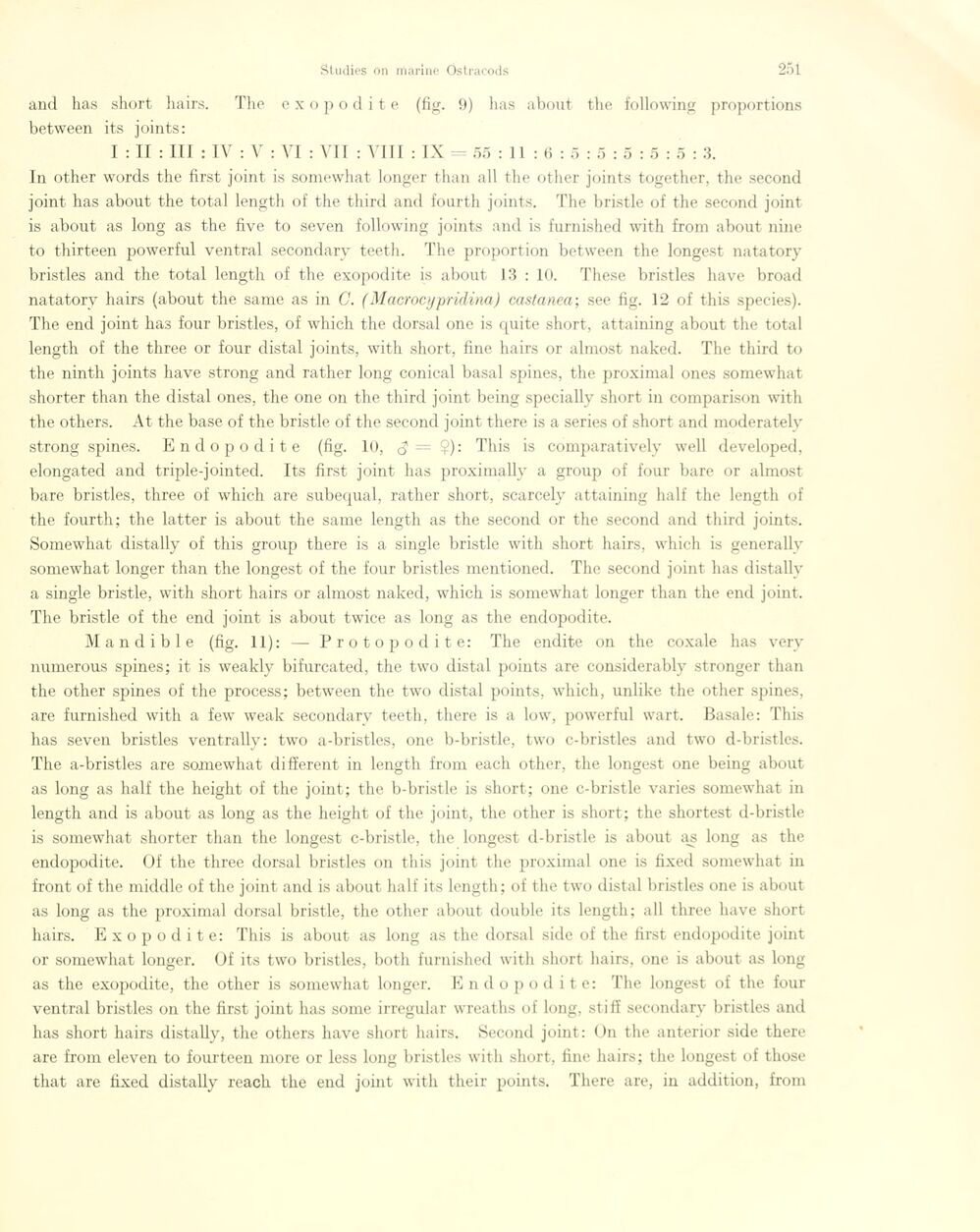
Full resolution (JPEG) - On this page / på denna sida - Sidor ...

<< prev. page << föreg. sida << >> nästa sida >> next page >>
Below is the raw OCR text
from the above scanned image.
Do you see an error? Proofread the page now!
Här nedan syns maskintolkade texten från faksimilbilden ovan.
Ser du något fel? Korrekturläs sidan nu!
This page has never been proofread. / Denna sida har aldrig korrekturlästs.
and has short hairs. The exopodite (fig. 9) has about the following proportions
between its joints:
I : II : III : IV : V : VI : VII : VIII : IX 55 : 11 : 6 : 5 : 5 : 5 : 5 : 5 : 3.
In other vvords the first joint is somewhat longer than ail the other joints together, the second
joint has about the total length of the third and fourth joints. The bristle of the second joint
is about as long as the five to seven following joints and is furnished with from about nine
to thirteen powerful ventral secondary teeth. The proportion between the longest natatory
bristles and the total length of the exopodite is about 13 : 10. These bristles have broad
natatory hairs (about the same as in G. (Macrocypridina) castanea-, see fig. 12 of this species).
The end joint has four bristles, of which the dorsal one is quite short, attaining about the total
length of the three or four distal joints, with short, fine hairs or almost naked. The third to
the ninth joints have strong and rather long conical basal spines, the proximal ones somewhat
shorter than the distal ones, the one on the third joint being specially short in comparison with
the others. At the base of the bristle of the second joint there is a series of short and moderately
strong spines. Endopodite (fig. 10, $ = Ç): This is comparatively well developed,
elongated and triple-jointed. Its first joint has proximally a group of four bare or almost
bare bristles, three of which are subequal, rather short, scarcely attaining half the length of
the fourth; the latter is about the same length as the second or the second and third joints.
Somewhat distally of this group there is a single bristle with short hairs, which is generally
somewhat longer than the longest of the four bristles mentioned. The second joint has distally
a single bristle, with short hairs or almost naked, which is somewhat longer than the end joint.
The bristle of the end joint is about twice as long as the endopodite.
Mandible (fig. 11): — Protopo dite: The endite on the coxale has very
numerous spines; it is weakly bifurcated, the two distal points are considerably stronger than
the other spines of the process; between the two distal points, which, unlike the other spines,
are furnished with a few weak secondary teeth, there is a low, powerful wart. Basale: This
has seven bristles ventrally: two a-bristles, one b-bristle, two c-bristles and two d-bristles.
The a-bristles are somewhat different in length from each other, the longest one being about
as long as half the height of the joint; the b-bristle is short; one c-bristle varies somewhat in
length and is about as long as the height of the joint, the other is short; the shortest d-bristle
is somewhat shorter than the longest c-bristle, the longest d-bristle is about as long as the
endopodite. Of the three dorsal bristles on this joint the proximal one is fixed somewhat in
front of the middle of the joint and is about half its length; of the two distal bristles one is about
as long as the proximal dorsal bristle, the other about double its length; all three have short
hairs. Exopodite: This is about as long as the dorsal side of the first endopodite joint
or somewhat longer. Of its two bristles, both furnished with short hairs, one is about as long
as the exopodite, the other is somewhat longer. Endopodite: The longest of the four
ventral bristles on the first joint has some irregulär wreaths of long, stiff secondary bristles and
has short hairs distally, the others have short hairs. Second joint: On the anterior side there
are from eleven to fourteen more or less long bristles with short, fine hairs; the longest of those
that are fixed distally reach the end joint with their points. There are, in addition, from
<< prev. page << föreg. sida << >> nästa sida >> next page >>